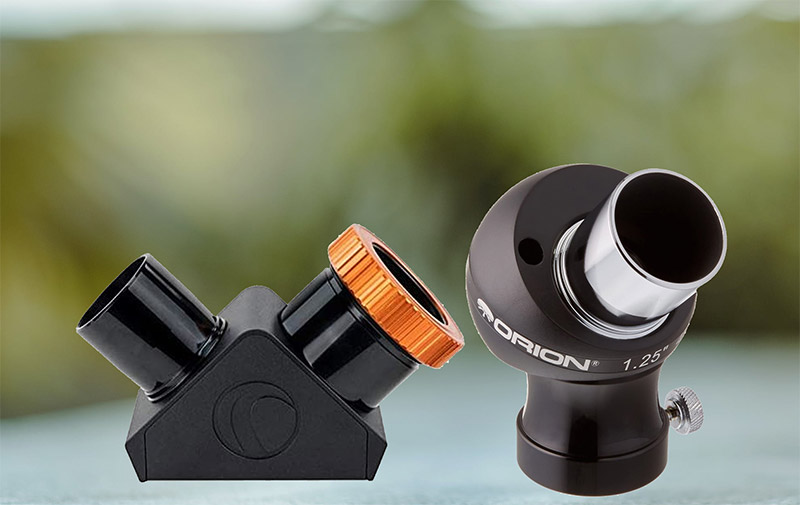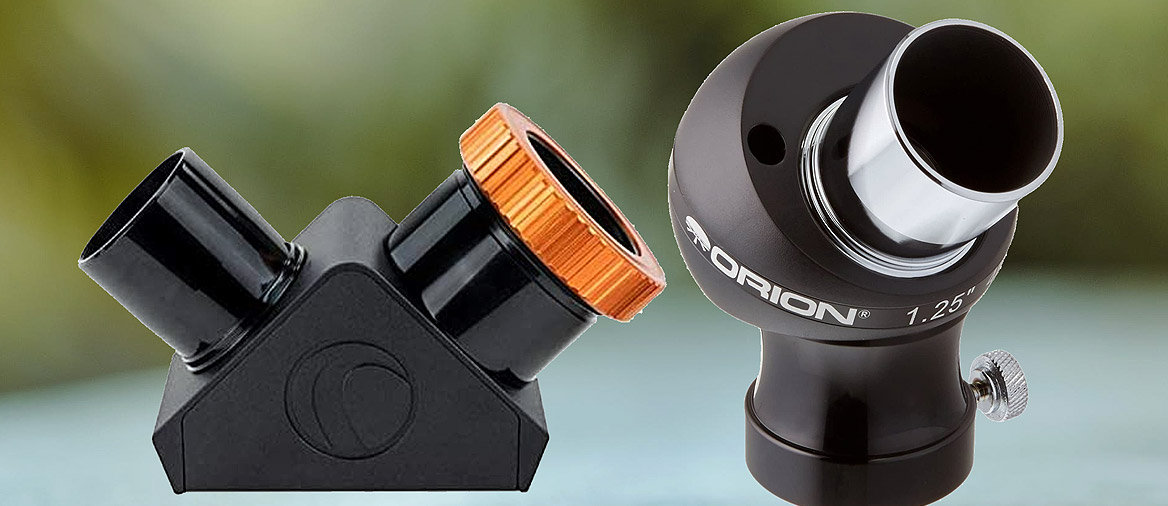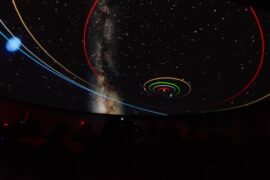It’s the age-old question that is always heard in star viewing parties. “Which is a better diagonal? Erecting prisms or mirror diagonals?”. “Mine performs better”, “no, mine gives sharper images”, and so on for hours. So, what’s the definitive answer? well…
The difference between prism and mirror diagonals is in their design and materials. Prisms use lenses while mirror diagonals obviously use mirrors. They are both effective designs and the answer to which one is better is: it depends on your telescope.
The objective of a star diagonal is to make the viewing angle more comfortable on certain types of telescopes. Specifically, refractor and catadioptric (Schmidt-Cassegrain and Maksutov) designs. The other advantage of using one is that these accessories invert the image upside down so you can see the correct side up when using them.
Differences between an erecting prism and a mirror diagonal

While they serve similar purposes, prisms and mirror diagonals have different designs and achieve the same result in different ways.
Erecting prisms use a lens that is shaped like an irregular pentagon to bend the light and bounce it at a 90° angle. This flips the image horizontally and keeps the horizontal alignment.
Mirrors, also known as star diagonals, reflect the light using a simple mirror at a 45° angle. This flips the image vertically, like prisms, but has the side effect of inverting it left-right, which means the resulting image is in the correct upside-down direction but is now horizontally inverted. For most people, this isn’t a big deal, but some find it a little bit disorienting.
Both designs have pros and cons. The following table compares them both.
| Erecting Prism | Mirror Diagonal | |
|---|---|---|
| Inner materials | Lens | Mirrors |
| Image direction | Vertically and horizontally correct | Vertically upright, horizontally flipped |
| Light scattering | No | Yes |
| Longevity | High | Medium |
| Probability of introducing color errors | Low to mid | Low to None |
| Requires collimation | No | Yes |
Let’s explain a few of those that might not be clear.
Light scattering
The coating that is used to produce the reflective mirrors in diagonals causes light to scatter when it bounces off it. This reduces the contrast of the final image.
Prisms do not have this problem as light passes through them instead of being bounced, so prisms do offer better contrast.
Point for prisms.
Color errors (Chromatic aberrations)
On the other hand, prisms often produce what is called “false color” or “chromatic aberrations” which basically just means they end up showing a slightly different shade of color in the minor cases and a completely different color in the worst.
How many color errors, how noticeable they are, and under what circumstances the prism introduces them depends on the quality of the prism and its age. High-quality prisms reduce this problem to a minimum to the point where you might not even notice them unless you are actively looking for them and you have a trained eye.
This problem is highly reduced, and almost non-existent in telescopes with longer focal lengths but we’ll talk more about that in the next section.
Point for diagonals.
Longevity
Wait, what? mirrors can “age”?
Kind of. The reflective coating in mirrors can oxidize, which means they have a shorter lifespan. We are talking years here so it’s not like they are disposable, but it is something to consider.
Moder dielectric mirrors solve this problem for the most part, but they are slightly more expensive.
Collimation
Just like telescopes that use mirrors, diagonals need to be collimated every once in a while. Collimating is just a fancy word for re-aligning.
Doing this is not too hard but it’s something you might want to take into account if for example, a kid is going to be the main user.
Price
As you can see, both are pretty equal when it comes to their pros and cons.
As for price, Prisms are slightly more expensive to manufacture. This is a problem mainly for the diagonals made for 2″ eyepiece connectors as they need larger prisms. For 1.25″ diagonals, there’s a wide range of options of both, from budget to premium.
Prism or Mirror, which one is best for your telescope?
Here’s the quick rule of thumb. Prisms are better for telescopes with a short focal length. Mirrors are better for telescopes with a longer focal length.
Why?
As mentioned in the last section mirrors scatter light, creating dimmer and lower contrast images. When you have a short focal length (or a “fast” telescope as some say in the biz), the light doesn’t scatter as much. This means that if the main drawback of mirrors is minimized, or almost non-existent, then using a mirror makes a lot of sense.
On the other hand, the longer focal length and the design of some Cassegrain (“slow”) telescopes minimize the color issues that prisms have due to the angle of the light. Again, when you take out its main issue, prisms become the better choice for these devices.
Another rule of thumb that is slightly less scientific because it mostly comes from anecdotical evidence in astronomy groups, is that when it comes to accessories, you almost always get a better image when you pair accessories with lenses with telescopes that also use lenses, same for mirrors with mirrors.
Longer focal length telescopes generally use mirrors (this is explained in depth in our article about telescope types), so it does make sense to mirror diagonals with them, and while prisms aren’t really technically lenses, they do refract light similarly so you pair them together.
Now that you have all the information, if you are ready to decide on a diagonal, check out our reviews of the best star diagonals.
Summary
- The best diagonal is going to depend on the type of telescope you have.
- Both erecting prisms and mirror diagonals have balanced pros and cons.
- Pair mirror diagonals with slow (long focal length) telescopes, and prisms with fast (short focal length) telescopes.
Enjoyed this article?
Get daily 10-minute PDFs about astronomy to read before bed!
Sign up for our upcoming micro-learning service where you will learn something new about space and beyond every day while winding down.







